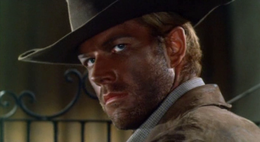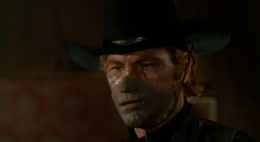El Rojo Review: Difference between revisions
mNo edit summary |
No edit summary |
||
| Line 1: | Line 1: | ||
<div style="float:right;width:245px;border:1px solid gray; padding:5px; margin:5px;"> | |||
<center>[[File:Rojo222.jpg|240px]]</center> | |||
<center> [[File:Trennlinie01.jpg|160px]] </center> | |||
[[Rojo, El|See Database Page]] | <center> [[Rojo, El|See Database Page]] </center> | ||
</div> | |||
'''Director:''' Leopold Savona, Mario Costa - '''Cast:''' Richard Harrison, Nieves Navarro, Piero Lulli, José Jaspe, Mirko Ellis, Franco Ressel, Rita Klein, Raf Baldassare, Janos Bartha, Tom Felleghi, '''Music:''' Benedetto Ghilglia | |||
<center> [[File:Trennlinie01.jpg|160px]] </center> | |||
In the opening scene a family of Scandinavian settlers is massacred, apparently by Indians. Some twenty years later, a stranger arrives in the town of Gold Hill, built on the spot of the massacre. At the same time, the four people dominating (practically owning) the town, Lasky, Ortega, Navarro and Wallace, receive a message that they deserve to die. The stranger starts picking them off one by one, assisted by an Indian (who was present at the slaughter) and a traveling salesman, who also turns out to be an inventor of sophisticated firearms. | In the opening scene a family of Scandinavian settlers is massacred, apparently by Indians. Some twenty years later, a stranger arrives in the town of Gold Hill, built on the spot of the massacre. At the same time, the four people dominating (practically owning) the town, Lasky, Ortega, Navarro and Wallace, receive a message that they deserve to die. The stranger starts picking them off one by one, assisted by an Indian (who was present at the slaughter) and a traveling salesman, who also turns out to be an inventor of sophisticated firearms. | ||
El Rojo is quite a bizarre movie. The opening scene, with the Indian attack on the family, is horrendous, one of the worst scenes of the entire genre, but the movie picks up a little along the ride. It has an episodic structure, like that other revenge western with Harrison, [[Joko invoca Dio... e muori|Vengeance]], and an intricate, well-conceived detective plot, more of the ''what-happened'' than the ''whodunit'' kind. It's clear from the beginning that the four dignitaries were involved in the massacre of the Sorenson family, and that Harrison is seeking revenge on them, but it's only revealed in the film's finale what happened, and what was the real purpose of the crime. This is well-done, but unfortunately it's the only story element that is developed properly, in a movie that is full of loose ends. | |||
<center> [[File:Vlcsnap-2013-02-22-17h49m46s55.png|260px]] [[File:Vlcsnap-2013-02-22-17h50m53s246.png|260px]] </center> | |||
The character played by José Jaspe is called a veteran of the Civil War in the English language version, but according to Giusti, he's supposed to be an ''ex-Garibaldini'', a volunteer who followed Giuseppe Garibaldi during his campaign in southern Italy. He has moved to the US and now uses his war experiences to provide Harrison - in Q style - with his latest inventions. The funny thing is that most of these novelties (a rifle that is said to be unique, a pistol with a silencer) are never used in the movie. In another scene, an alternative explanation is suggested for his inventiveness: when Harrison draws a portrait of beautiful Nieves Navarro, he's called Michelangelo by one of the bystanders. Does Jaspe's character by any chance refer to Michelagelo's contemporary Leonardo Da Vinci, a man known in all four corners of the world for his weird inventions? Michelangelo and Leonardo in a spaghetti western, how about that? To make things even more outlandish, there's also a character who haunts the movie like the Phantom of the Opera, a mysterious gunslinger (called Black Bart in the English, Nero Rourke in the Italian language version) who hides his mutilated face behind a mask. He just seems to be there, for no particular reason, but then, all of a sudden, he faces Harrison in the dying moments of the film, telling him that the two of them will make a nice pair, ''the Red and the Black''. It's an almost surreal ending to an already weird movie. | The character played by José Jaspe is called a veteran of the Civil War in the English language version, but according to Giusti, he's supposed to be an ''ex-Garibaldini'', a volunteer who followed Giuseppe Garibaldi during his campaign in southern Italy. He has moved to the US and now uses his war experiences to provide Harrison - in Q style - with his latest inventions. The funny thing is that most of these novelties (a rifle that is said to be unique, a pistol with a silencer) are never used in the movie. In another scene, an alternative explanation is suggested for his inventiveness: when Harrison draws a portrait of beautiful Nieves Navarro, he's called Michelangelo by one of the bystanders. Does Jaspe's character by any chance refer to Michelagelo's contemporary Leonardo Da Vinci, a man known in all four corners of the world for his weird inventions? Michelangelo and Leonardo in a spaghetti western, how about that? To make things even more outlandish, there's also a character who haunts the movie like the Phantom of the Opera, a mysterious gunslinger (called Black Bart in the English, Nero Rourke in the Italian language version) who hides his mutilated face behind a mask. He just seems to be there, for no particular reason, but then, all of a sudden, he faces Harrison in the dying moments of the film, telling him that the two of them will make a nice pair, ''the Red and the Black''. It's an almost surreal ending to an already weird movie. | ||
Revision as of 11:06, 3 August 2015
Director: Leopold Savona, Mario Costa - Cast: Richard Harrison, Nieves Navarro, Piero Lulli, José Jaspe, Mirko Ellis, Franco Ressel, Rita Klein, Raf Baldassare, Janos Bartha, Tom Felleghi, Music: Benedetto Ghilglia
In the opening scene a family of Scandinavian settlers is massacred, apparently by Indians. Some twenty years later, a stranger arrives in the town of Gold Hill, built on the spot of the massacre. At the same time, the four people dominating (practically owning) the town, Lasky, Ortega, Navarro and Wallace, receive a message that they deserve to die. The stranger starts picking them off one by one, assisted by an Indian (who was present at the slaughter) and a traveling salesman, who also turns out to be an inventor of sophisticated firearms.
El Rojo is quite a bizarre movie. The opening scene, with the Indian attack on the family, is horrendous, one of the worst scenes of the entire genre, but the movie picks up a little along the ride. It has an episodic structure, like that other revenge western with Harrison, Vengeance, and an intricate, well-conceived detective plot, more of the what-happened than the whodunit kind. It's clear from the beginning that the four dignitaries were involved in the massacre of the Sorenson family, and that Harrison is seeking revenge on them, but it's only revealed in the film's finale what happened, and what was the real purpose of the crime. This is well-done, but unfortunately it's the only story element that is developed properly, in a movie that is full of loose ends.


The character played by José Jaspe is called a veteran of the Civil War in the English language version, but according to Giusti, he's supposed to be an ex-Garibaldini, a volunteer who followed Giuseppe Garibaldi during his campaign in southern Italy. He has moved to the US and now uses his war experiences to provide Harrison - in Q style - with his latest inventions. The funny thing is that most of these novelties (a rifle that is said to be unique, a pistol with a silencer) are never used in the movie. In another scene, an alternative explanation is suggested for his inventiveness: when Harrison draws a portrait of beautiful Nieves Navarro, he's called Michelangelo by one of the bystanders. Does Jaspe's character by any chance refer to Michelagelo's contemporary Leonardo Da Vinci, a man known in all four corners of the world for his weird inventions? Michelangelo and Leonardo in a spaghetti western, how about that? To make things even more outlandish, there's also a character who haunts the movie like the Phantom of the Opera, a mysterious gunslinger (called Black Bart in the English, Nero Rourke in the Italian language version) who hides his mutilated face behind a mask. He just seems to be there, for no particular reason, but then, all of a sudden, he faces Harrison in the dying moments of the film, telling him that the two of them will make a nice pair, the Red and the Black. It's an almost surreal ending to an already weird movie.
No less than seven screenwriters contributed to the script, and apparently there was also more than one director. According to assistant-director Gianfranco Baldonallo, the original director was Mario Costa, but he was replaced by Leopold Savona after a series of differences with Harrison. It is, in other words, a work of many spiritual fathers, which may well explain its episodic structure and lack of coherence. Harrison is his usual immovable self, steady as a rock, throwing sugar lumps to ladies and gentlemen admiring his wall-to-wall shoulders (Why? No idea). Nieves Navarro sings a song (or at least mimes it) but is otherwise underused. Piero Lulli is in fine form as the major villain and Raf Baldassare is also remarkable as his right hand. Benedetto Ghilgia's score is highlighted by a delicious trumpet played by Michele Lacerenza.
Who is El Rojo?
Harrison is called 'The Red' (by the man with the mask) in the final scene, but it's the first time this knick-name is used and it's not clear why he is actually called the Red. The message that the four corrupt dignitaries must die, is brought to them ('by arrow') by the Indian (called Cochise!), that is: the redskin. Is he supposed to be El Rojo? It seems not very likely. Jaspe's character is an ex-Garibaldini. The Garibaldini's are called le camicie rosse (the red shirts) in Italian, so he's also a suspect. But it seems unlikely that a director (or producer) would like to call a movie after a supporting character, so Harrison remains the principal suspect. He's a fair-skinned man from the north (of Europe), so maybe his skin turned red in the Italian sun. In other words: I don't know.
--By Scherpschutter




